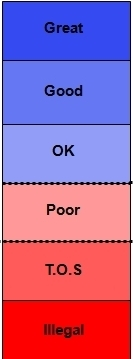My friend Randy Farmer recently co-authored the new book Building Web Reputation Systems. I’ve just started reading the book, and if first impressions are anything, Randy and Bryce Glass have put together one hell of a worthy read. In order to celebrate the launch (and encourage you to go buy what is almost certain to be a great read), I’ve invited Randy and Bryce to guest post here, specifically riffing off the moderation post I recently wrote.
Be sure to leave a comment – maybe they’ll come back for another guest post!
Find Randy and Bryce at: http://buildingreputation.com
You can also check out my interview with Randy back in December 2008.
—
There’s a Whole Lotta Crap Out There
Sturgeon’s Law:
Ninety percent of everything is crud. — Theodore Sturgeon, author, March 1958
In Building Web Reputation Systems, we describe a number of content-moderation models specifically geared at high-volume, high-contribution web sites, but many of these same concepts scale down to lower volume sites as well.
Regardless of where your site falls along the spectrum of contribution volume, you are likely to find out that much of what’s contributed just may not be that good. Filtering and sorting the best and most relevant content is what web search engines such as Google are all about. Sorting the wheat from the chaff is a multibillion dollar industry.
Think of user-contributed content in your community as if it lies along a continuum of quality:

Content at the higher end of the scale should be rewarded, trumpeted, and showcased.
Stuff on the lower registers will either be ignored, hidden or reported to the authorities.
The great content typically is identified by reputation systems, by local site editors, or by a combination of the two, and it is often featured, promoted, highlighted, or rewarded. These contributions are the superstars of your site, and should be showcased as such. On YouTube, The Evolution of Dance was just such a breakaway hit, and Red vs. Blue is a long-standing, quality fan-favorite.
The primary goal of a social media site should be to make user-generated content of good quality constitute the bulk of what users interact with regularly. To reach that goal, user incentive reputation systems are often combined with content quality evaluation schemes. Again on YouTube, you will find thousands upon thousands of good, solid contributions. So many that good examples are hard to find in isolation: but here is a nice ukelele performance with a modest number of views and crowd response.
Like an off-color joke delivered in mixed company, seemingly inappropriate content may become high quality content when it’s presented in another context. The quality of such content may be OK, but moving or improving the content will move it up the quality scale. On an ideal social media site, community members would regularly only encounter content that is OK or better. Depending on your tastes, this video is either OK, or not. But you won’t find it highlighted on YouTube’s homepage!
Unfortunately, when a site has the minimum possible social media features-such as blog comments turned on without oversight or moderation-the result is usually a very high ratio of poor content. As user-generated content grows, content moderation of some sort is always required: typically, either employees scan every submission or the site’s operators deploy a reputation system to identify bad content. Simply removing the bad content isn’t usually good enough-most sites depend on search engine traffic, on advertising revenue, or both. To get search traffic, external sites must link to the content, and that means the quality of the content has to be high enough to earn those links. (No YouTube example provided—it’s too painful to go looking for them.)
Then there are submissions that violate the terms of service (TOS) of a social web site. Such content needs to be removed in a timely manner to avoid dragging down the average quality of content, degrading the overall value of the site.
Finally, if illegal content is posted on a site, not only must it be removed, but the site’s operators may be required to report the content to local government officials. Such content obviously must be detected and dealt with as quickly and efficiently as possible.
For sites large and small, the worst content can be quickly identified and removed by a combination of reputation systems and content moderators. But that’s not all reputations can do. They also provide a way to identify, highlight, and reward the contributors of the highest quality content, motivating them to produce their very best stuff.